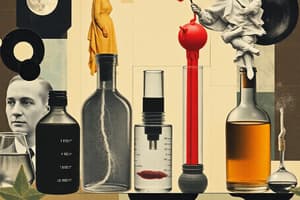Podcast
Questions and Answers
What is the purpose of a negative control in an experimental design?
What is the purpose of a negative control in an experimental design?
- To test the reliability of the results from all conditions
- To ensure the experiment is conducted under optimal conditions
- To provide a known measurement of the effect of the treatment
- To establish a baseline measurement without any treatment effect (correct)
Why is it important to use the same source for experimental organisms?
Why is it important to use the same source for experimental organisms?
- To minimize ethical concerns regarding the treatment
- To ensure all organisms respond similarly to treatments (correct)
- To reduce the time taken to complete the experiment
- To comply with regulatory requirements in research
What is the purpose of having multiple replicas in each treatment condition?
What is the purpose of having multiple replicas in each treatment condition?
- To enhance the statistical validity of the results (correct)
- To compare different treatment conditions against each other
- To identify the maximum concentration of the treatment
- To ensure all instruments are properly calibrated
Which of the following is a characteristic of a positive control in an experiment?
Which of the following is a characteristic of a positive control in an experiment?
How should instruments be handled before the experiment begins?
How should instruments be handled before the experiment begins?
What is the primary purpose of having a backup plan for an experiment?
What is the primary purpose of having a backup plan for an experiment?
Which statement best describes the importance of processing raw data to processed data?
Which statement best describes the importance of processing raw data to processed data?
What is a statistically robust sampling plan used for?
What is a statistically robust sampling plan used for?
In the context of experiments, what is calibration primarily concerned with?
In the context of experiments, what is calibration primarily concerned with?
What is one key consideration when outsourcing experiments?
What is one key consideration when outsourcing experiments?
Flashcards are hidden until you start studying
Study Notes
Experimental Design Essentials
- Formulate a clear hypothesis, such as the effect of banana extract on Salmonella typhae growth.
- Hypotheses can indicate potential outcomes: inhibition, toxicity, or no effect (null).
- Maintain confidence in the hypothesis while remaining adaptable to outcomes.
Controls in Experiments
- Implement a Negative Control, e.g., solvent and Salmonella typhae culture with no treatment.
- Include a Positive Control using a known antibiotic with the same solvent and culture.
- Establish Treatment Conditions with various concentrations of the extract alongside the culture.
- Ensure at least three replicates for each condition to validate results.
Source of Variability
- Recognize that using organisms from different sources can introduce variabilities in experiments.
- Maintain consistency in the source, age, and dealer of test organisms to avoid confounding data.
Data Management
- Prepare templates for real-time data collection, including spectrophotometric readings or physical measurements.
- Use software like Excel for managing data templates, ensuring physical copies are easily accessible.
- Log data promptly and seek supervisor verification to maintain accuracy.
Contingency Planning
- Develop a backup plan to address potential experimental failures or delays in execution.
- Assess logistics, costs, and availability in advance if outsourcing any experimental components.
Data Processing and Sampling Strategies
- Process raw data promptly instead of storing it long-term, adopting efficient folder management techniques.
- Determine a robust sampling plan to statistically evaluate populations, especially when assessing disease prevalence in plants or animals.
- Analyze all data statistically to enhance experiment validity.
Discussion Points for Consideration
- Evaluate the design of the experiment and expected hypotheses thoroughly.
- Consider potential inefficiencies in replicates and their impact on experimental outcomes.
- Draft simple data templates in Excel for effective data capturing.
- Identify possible sources of variation within the experimental setup.
- Understand what outsourcing experiments/samples entails and its implications.
- Differentiate between raw data (initial data collected) and processed data (analyzed, formatted data).
- Explore methods of sampling and its relevance to empirical research.
- Grasp the importance of instrument calibration in ensuring accuracy of experimental results.
Studying That Suits You
Use AI to generate personalized quizzes and flashcards to suit your learning preferences.




